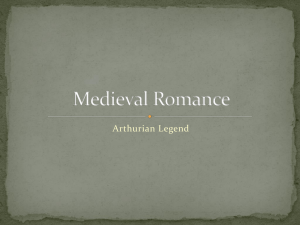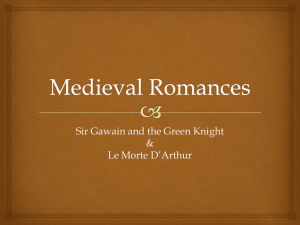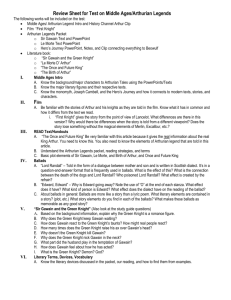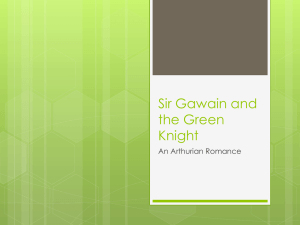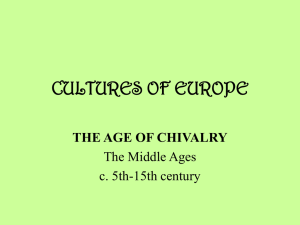Sir Gawain and the Green Knight
advertisement
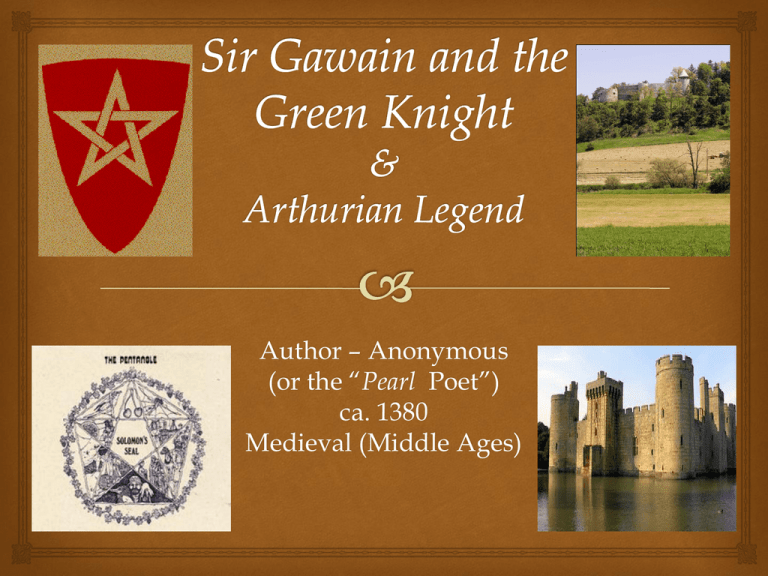
Author – Anonymous (or the “Pearl Poet”) ca. 1380 Medieval (Middle Ages) Sir Gawain and the Green Knight “Pearl Poet” or the “Gawain Poet” Authorship for SGGK is typically considered anonymous, or it is attributed to a mysterious, unknown poet since named “The Pearl Poet.” This poet wrote an alliterative poem titled The Pearl, and a similar dialect and style is present in several other works, including SGGK. He was certainly English and spoke and wrote in Middle English. This poet is sometimes referred to as the “Gawain Poet.” Sir Gawain and the Green Knight Time Period Medieval (Middle Ages) ca. 476 A.D. – 1453 A.D. This is the time between antiquity (Classical Greece, the Roman Empire, etc.) and the Renaissance. More specifically, 476 A.D. marks the fall of the Western Roman Empire and 1453 A.D. marks the fall of the Eastern Roman Empire and a rebirth of the cultural movements of antiquity. The Middle Ages stretches the period “between,” and encompasses a great deal of literature of both secular and religious works, including “adventure narratives.” Sir Gawain and the Green Knight Adventure Narratives of the Middle Ages Adventure narratives in this time period were dominated by stories from three areas or “matters”: The Matter of Rome: stories of ancient Roman heroes involved in exciting adventure, physical or involving love – “Romance” Sir Gawain and the Green Knight Adventure Narratives of the Middle Ages The Matter of France: stories involving the French hero Roland (Orlando in Italian). The Matter of Britain: stories involving chivalry, especially that of King Arthur and the Knights of the Round Table (Camelot) or Arthurian Legend. The Arthurian Legend – The Past and Present Arthurian Legend Somehow the Arthurian legends actually developed in the ancient world, probably with the Celts who would eventually make up Britain. Basic elements of the Arthurian legend were first introduced into the literary world by Geoffrey of Monmouth’s History of the Kings of Britain (ca. 1139) Poetic translation of Roman de Brut by Layamon introduced the legends of Excalibur (famous sword) French author Chretien de Troyes introduced Lancelot The English Knight Sir Thomas Malory codified the Arthur legends in Morte D’Arthur (1485) The Arthurian Legend – The Past and Present Arthurian Legend Today *Arthurian legends even last to today with pop culture taking on the Matter of Britain (e.g., Disney’s The Sword in the Stone, Broadway’s Camelot, First Knight, and in satire, Monty Python’s Holy Grail) Arthurian Legend and Chivalry Chivalric Ideal: The Knights of the Round Table were the most famous for this behavior in the Middle Ages. The classic definition of chivalry: men were brave, had honor, and showed gallantry towards women; Christian values in warfare (rules of engagement because “the enemy is my brother”); usually a good lover; courtesy to all people is key—being a gentleman in all situations is important; willing to sacrifice yourself for your lord and ladies (for the weak). Arthurian Legend Courtly Love Courtly Love: the love a knight has for a woman who is generally not his wife. It is a love from “afar” and it is usually very superficial (it is often explained, for example, with a knight who is struck by cupid’s arrow as he sees a beautiful maiden walking out of a castle. Arthurian Legend Courtly Love Courtly Love is also generally unattainable (at most, the knight may get a kiss, but that is all). Often the maiden is married to the King (e.g., Arthur & Guinevere and then Lancelot comes into the picture). Courtly Love creates a situation where the knight seeks to impress the lady from afar by doing brave deeds and being the perfect gentleman (showing great chivalry). Sir Gawain and the Green Knight Elements of the Legends and This Story Medieval romances (adventures) were frequently episodic as is the case with the Arthurian legends. The best of these stories are carefully constructed (not at random) and the details tend to “count.” SGGK is an example of this because it combines two distinct sort of adventures (the beheading contest and the events at Bercilak’s castle) . Gawain’s trouthe (his real character) is repeatedly tested in this as well as his loyalty: to Arthur and to the chivalric code. Sir Gawain and the Green Knight Elements of the Legends and This Story Christian themes are major themes in the story, because not only is the poet a Christian, but the knights are as well. It’s important to understand that the poet may not always be agreeing with the chivalric code. Strangely, however, there are pagan Celtic themes as well, especially in dealing with nature and “magical” elements. What is particularly important is the nature of Gawain’s “trouthe” or his “true character,” symbolized by the star on his shield or “Pentangle.” The Pentangle in SGGK What the Pentangle symbolizes: 1. Five Senses Faultless 2. Five Fingers That Never Failed 3. Five Wounds of Christ 4. Five Joys of Mary: A. Annunciation B. Nativity C. Resurrection D. Ascension E. Assumption 5. Gawain’s Virtues (boundless beneficence (being kind and charitable), brotherly love, pure mind, manners, & compassion) Sir Gawain and the Green Knight The Gawain Poet • Identity of the poet is unknown, but the manuscript was found in a collection including three other poems (Pearl, Patience, and Purity), all religious poems: the only manuscript of the poem. • The poem was probably composed some time between 1375-1400: the time that Chaucer was writing—many hundred years after Beowulf. • We have the poem in translation, but Chaucer in the original Middle English. (Chaucer uses a dialect of English that would become Modern English). The Legend of King Arthur • A vast complex of stories center around King Arthur and his court. Even if we are not familiar with the different stories, the names associated with Arthur and his court are familiar: Sir Lancelot, Sir Gawain, Queen Guenevere, Merlin the Magician, the Round Table, Camelot. • A historical "Arthur" may have existed as a Celtic cavalry leader who fought against invading Saxon forces in the early 6th century. • The Celts had a history of defeats, and Arthur was probably a "heroic creation of a defeated people." The Arthurian legend provided England with an aristocratic myth of its past glories. The Legend of King Arthur and Sir Gawain and the Green Knight • When the Gawain-poet was writing, in the 14th century, the Arthurian legends had been told and retold over and over, and the legends themselves and the idealism of the court were increasingly being treated in a debased fashion. • The poem suggests the decadence of the Arthurian tradition. • This reflects the social changes of 14th century England -the aristocratic ideals were kept alive through tournaments and the founding of chivalric orders, but social changes cause the Gawain-poet both to praise and to call into question the past and its aristocratic ideals. Arthur's Court (Lines 37 to 106) -- Identify and explain any words, phrases, or comments the poet makes about Arthur's court that may be criticisms of it. • Too much emphasis on pleasure. • Too much emphasis on worldly goods. • Seems to be almost a self-contained fantasy world. • The knights are untested; they seem almost to be children. • Very controlled world, removed from nature -- established times for "wonders.“ • Portrayed as a very civilized world. • What we might call a decadent portrayal of King Arthur's court = "Being in a state of decline or decay." Gawain’s request to stand before Arthur (Lines 343-347) • seems almost a parody of courtly manners The entrance / depiction of the Green Knight (Lines 222 to 283, Lines 301-322) -- Identify in what ways the Green Knight stands in contrast to Arthur's court and in what ways the Knight seems to criticize or belittle the court. Who is this strange green man? • Seems to show how fragile this world is as he comes riding in and makes his challenge. • He see the knights as unworthy to battle against him = young and untested. • Pretends not to know which one of the men is King Arthur (and he probably is pretending). The entrance / depiction of the Green Knight (Lines 222 to 283, Lines 301-322) -- Identify in what ways the Green Knight stands in contrast to Arthur's court and in what ways the Knight seems to criticize or belittle the court. Who is this strange green man? • He knows of the history of Arthur's court, but he suspects they are not all that they have been made out to be. • Closely associated with the natural world (images to describe the green knight are drawn from nature). • May represent an earlier time, when people were less corrupted by civilization. • May even be a remnant of some earlier god associated with fertility and nature. Gawain’s Pentangle (Lines 619-669) The “Five Fives” 1. Five senses = should be faultless 2. Five fingers = probably refers to strength 3. Five wounds of Christ = to remember Christ’s suffering on the Cross 4. Five Joys: Annunciation, Nativity, Resurrection, Ascension, Assumption 5. Five moral qualities: beneficence boundless, brotherly love, pure mind, pure manners, compassion The Courtly Love Tradition • Courtly Love: “a highly conventionalized code of conduct for lovers during the Middle Ages” • Adoration for the Virgin Mary, was, in part, responsible for a philosophy of love and a code of lovemaking that was a popular and important aspect of chivalry. • Bertilak's wife is entering Gawain's room with expectations of a courtly romance. The Courtly Love Tradition • Andreas Capellanus (late 12th century) wrote an indepth treatise on courtly love, which included its 31 "rules.“ • True love was held to be impossible in a married state • By its very nature, courtly love is illicit and sensual, naturally leading to adultery. • A knight’s object of devotion would often be his lord's wife. • Queen Guenivere and Lancelot Gawain as a Hero • How has Gawain been tested? How well does Gawain succeed as a hero? • The third morning (lines 1826-1892) • Gawain and Lord Bertilak (lines 1932-1951) • Gawain and the Green Knight (lines 2345-2388)
